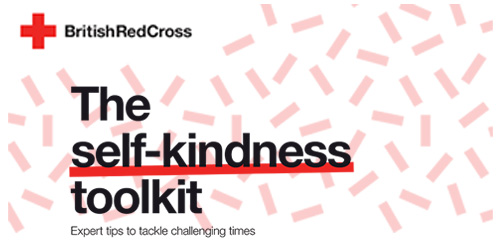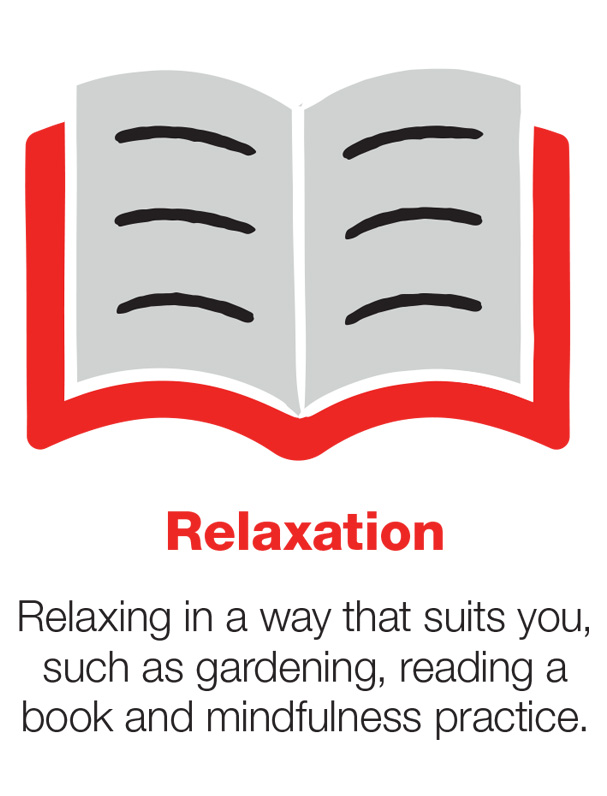The Self-kindness Toolkit: Part 3: Relaxation

The Self-kindness Toolkit: Expert tips to tackle challenging times
The British Red Cross has provided a toolkit full of useful, practical tips that you can use to help build your resilience and confidence and to take control when faced with challenging situations.
6 Rs of resilience
The 6 Rs of resilience can prepare you and your family so that you are better able to bounce back when faced with a difficult situation.
- Responsibility: Taking responsibility for your own mental health, wellbeing and resilience.
- Reflection: Reflecting on how you are, what is happening and how you are feeling about things.
- Relaxation: Relaxing in a way that suits you, such as gardening, reading a book and mindfulness practice.
- Relationships: Noticing the things we can take responsibility for can help to build confidence in ourselves and help us to feel more in control.
- Refuelling: Eating a healthy diet, and being conscious of alcohol intake.
- Recreation: Taking regular exercise, and having fun.
Over a series of articles, you will find tips on each of the 6 Rs. This article focuses on Relaxation.

Wellbeing: Easy mindfulness activities for you to enjoy
Mindfulness activities involve no more than being fully present and engaged in the moment, and being aware of our thoughts and feelings without judging them or getting too caught up in them.
Cooking
- Notice the smell and texture of each ingredient.
- Focus on the precision of repetitive tasks, such as chopping and stirring.
- Recognise the taste and smell of different foods as they cook.
- Involve the family and reconnect.
Dancing
- Move your body and dance if you can.
- Put on music that you enjoy and notice how you feel when your body responds.
- Notice how different songs, lyrics and rhythms make you feel.
- Create a wellbeing playlist of songs that affected your mood positively.
Appreciate or tend to nature
- Feel the texture of the soil, the roughness of weeds or the softness of flowers.
- Take in the smells of freshly cut grass and nectar.
- Look at the changing colours, textures and patterns of plants and flowers.
- Listen to the sounds of birds, lawnmowers and watering of plants.
Sleep techniques
Sleep is important for our physical and mental wellbeing. However, it is often most difficult to sleep during times when we need it most. Try and use the techniques below to help you wind down and set yourself up for sleep.
1. Journal before bed
Using a notebook or piece of paper, you can write about anything; how you are feeling, tasks you completed, movements you made, or even worries and concerns that you have. If you have written down your worries, how about trying to do our 'circles of control' task (see Responsibility section of the toolkit) with your list?
In your journal, write out the following headings:
- Today I am grateful for...
- Things I'm worried about...
- Movements I made...
- Things I'm exciting about...
You can find a template in the pdf toolkit.
2. Breathing exercises can help calm anxiety
Here are a few you can start with.
Breathing in colour
- Picture a colour you associate with happy, positive thoughts.
- Now picture another colour; for thoughts that are not positive.
- Take a slow breath in. Now picture breathing in that wonderful, positive colour. Imagine the breath is reaching your fingers and toes.
- Take a slow breath out and imagine you're breathing out the negative colour.
- Blow it far away from you.
- Repeat this exercise a few times.
Does it help? How do you feel now?
Box breathing
- Take a deep in breath. As you breathe in, count to four slowly. Notice the air entering your lungs.
- Now hold your breath and count to four. Avoid inhaling or exhaling.
- Release your breath slowly, again for four seconds.
- Repeat this process as many times as you need.
Did it help? How do you feel now?
3. Set a routine
Try to set a time to get into bed to create a routine, helping your body get used to regular sleeping times.
4. Limit screen time just before sleep
If you can, also attempt to remove 'blue light objects' such as phones and laptops, from your sleeping space.
5. Do something for you.
Find something relaxing that you enjoy doing before been can help towards a better night sleep. Maybe read something that interests you, dim the lights, have a cup of calming decaffeinated tea or listen to music.
Keeping your hands busy
At times when we are feeling anxious or overwhelmed, it can help to keep our hands busy. Look through your things – are there any items that you no longer need and could give to charity? Recycling items is a kind act which can give you satisfaction. Or you could upcycle your items – this is where you take something old and make it into something new. You can learn new skills and even share items with friends and family.
Why not try our mending guide below to keep your hands busy while also bringing an piece of clothing back to life? If you can’t think of a way to use the example below, explore ways to upcycle or repair your items through articles and videos online, local repair
groups, or go to your local library to find inspiration.
Guide to mending a hold in clothing
Put something hard underneath the hole: a cup or jar will do. Push the needle and thread through the front side of the fabric to the back. Now bring the needle through the back to the front. Repeat this process, weaving the needle through the fabric to create a line (running stitch) around the edge of the hole.
Now create lines across the hole using the same running stitch. When you get to the hole, pass over it to the other side and stitch again until you reach the border. Change direction and repeat until your hole is covered with lines.
Repeat the same process horizontally: weaving the thread under and over the lines that you created in the last step. When you’re done,
pass the thread through to the back, tie a small knot, and snip the thread short.
Tip: how about trying to create an image over your hole, like a flower or rocket?
You can find creative activities to download and print, and more self-kindness tips in the full Self-kindness Toolkit document.
Feedback
To give the British Red Cross feedback to help improve the resources please complete this short survey.
For more information please contact the Corporate Communications Team.


/prod01/wlvacuk/media/departments/digital-content-and-communications/images-2024/240328-Varsity-Line-Up-Resized.jpg)
/prod01/wlvacuk/media/departments/digital-content-and-communications/images-18-19/220325-Engineers_teach_thumbail.jpg)
/prod01/wlvacuk/media/departments/digital-content-and-communications/images-2024/240423-Additive-Research-Centre-Launched.jpg)
/prod01/wlvacuk/media/departments/digital-content-and-communications/images-2024/240320-Uzbekistan-Resized.jpg)
/prod01/wlvacuk/media/departments/digital-content-and-communications/images-2024/240229-The-Link-Resized.jpg)
/prod01/wlvacuk/media/departments/digital-content-and-communications/images-2024/240416-Abi-Dare-Resized.jpg)